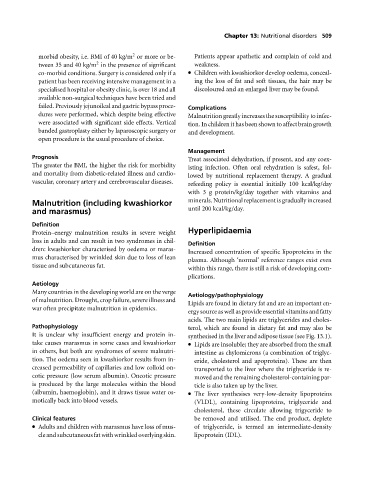Page 513 - Medicine and Surgery
P. 513
P1: KOA
BLUK007-13 BLUK007-Kendall May 13, 2005 16:24 Char Count= 0
Chapter 13: Nutritional disorders 509
2
morbid obesity, i.e. BMI of 40 kg/m or more or be- Patients appear apathetic and complain of cold and
2
tween 35 and 40 kg/m in the presence of significant weakness.
co-morbid conditions. Surgery is considered only if a Children with kwashiorkor develop oedema, conceal-
patient has been receiving intensive management in a ing the loss of fat and soft tissues, the hair may be
specialised hospital or obesity clinic, is over 18 and all discoloured and an enlarged liver may be found.
available non-surgical techniques have been tried and
failed. Previously jejunoileal and gastric bypass proce- Complications
dures were performed, which despite being effective Malnutrition greatly increases the susceptibility to infec-
were associated with significant side effects. Vertical tion. In children it has been shown to affect brain growth
banded gastroplasty either by laparoscopic surgery or and development.
open procedure is the usual procedure of choice.
Management
Prognosis Treat associated dehydration, if present, and any coex-
The greater the BMI, the higher the risk for morbidity isting infection. Often oral rehydration is safest, fol-
and mortality from diabetic-related illness and cardio- lowed by nutritional replacement therapy. A gradual
vascular, coronary artery and cerebrovascular diseases. refeeding policy is essential initially 100 kcal/kg/day
with3gprotein/kg/day together with vitamins and
Malnutrition (including kwashiorkor minerals. Nutritional replacement is gradually increased
and marasmus) until 200 kcal/kg/day.
Definition
Protein–energy malnutrition results in severe weight Hyperlipidaemia
loss in adults and can result in two syndromes in chil-
Definition
dren: kwashiorkor characterised by oedema or maras-
Increased concentration of specific lipoproteins in the
muscharacterised by wrinkled skin due to loss of lean plasma. Although ‘normal’ reference ranges exist even
tissue and subcutaneous fat. within this range, there is still a risk of developing com-
plications.
Aetiology
Many countries in the developing world are on the verge
Aetiology/pathophysiology
of malnutrition. Drought, crop failure, severe illness and
Lipids are found in dietary fat and are an important en-
war often precipitate malnutrition in epidemics.
ergy source as well as provide essential vitamins and fatty
acids. The two main lipids are triglycerides and choles-
Pathophysiology terol, which are found in dietary fat and may also be
It is unclear why insufficient energy and protein in- synthesised in the liver and adipose tissue (see Fig. 13.1).
take causes marasmus in some cases and kwashiorkor Lipids are insoluble; they are absorbed from the small
in others, but both are syndromes of severe malnutri- intestine as chylomicrons (a combination of triglyc-
tion. The oedema seen in kwashiorkor results from in- eride, cholesterol and apoproteins). These are then
creased permeability of capillaries and low colloid on- transported to the liver where the triglyceride is re-
cotic pressure (low serum albumin). Oncotic pressure moved and the remaining cholesterol-containing par-
is produced by the large molecules within the blood ticle is also taken up by the liver.
(albumin, haemoglobin), and it draws tissue water os- The liver synthesises very-low-density lipoproteins
motically back into blood vessels. (VLDL), containing lipoproteins, triglyceride and
cholesterol, these circulate allowing trigyceride to
Clinical features be removed and utilised. The end product, deplete
Adults and children with marasmus have loss of mus- of triglyceride, is termed an intermediate-density
cleandsubcutaneousfatwithwrinkledoverlyingskin. lipoprotein (IDL).

